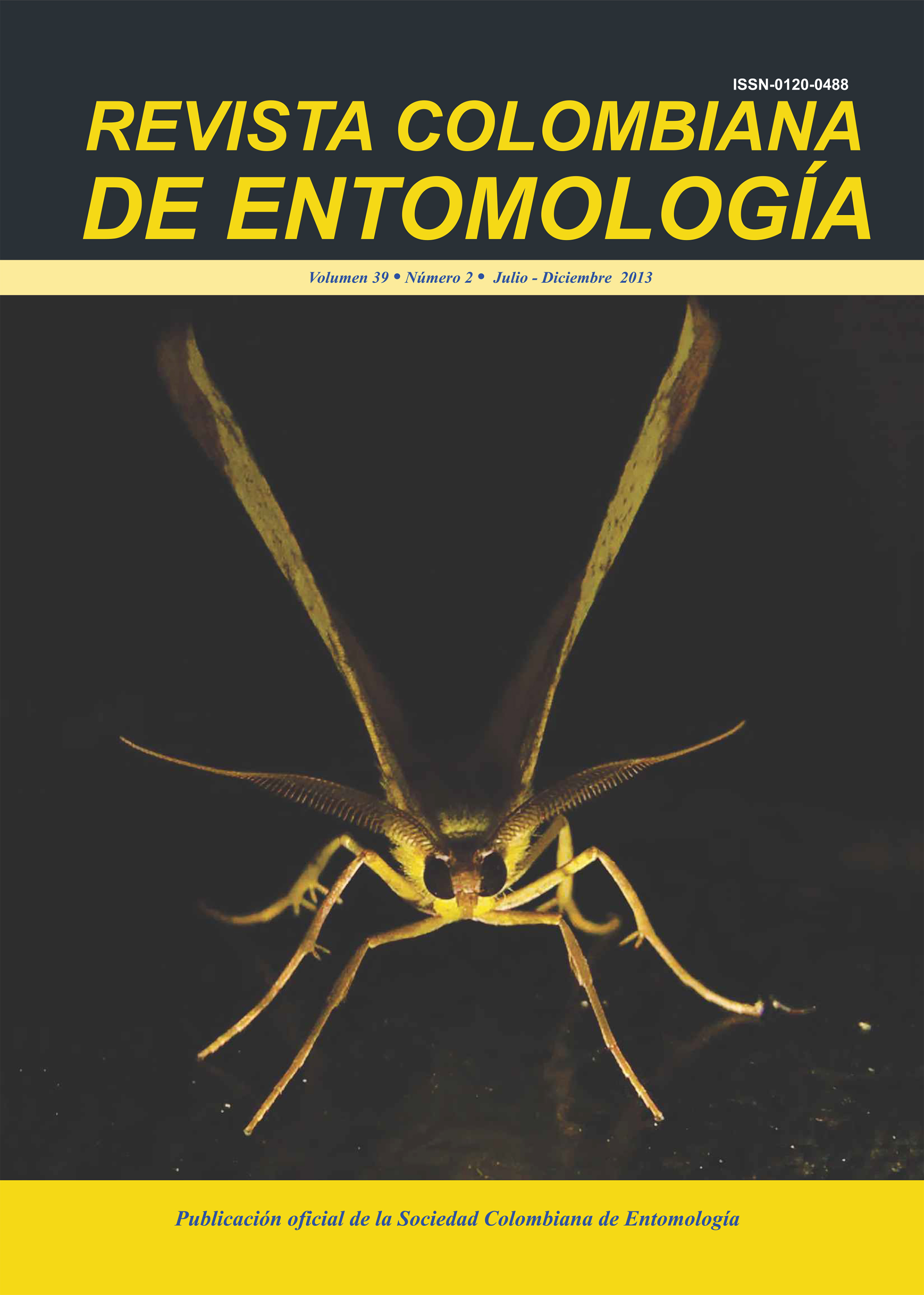Effect of carbonic anhydrase inhibitors on Anopheles albimanus larvae (Diptera: Culicidae)
Main Article Content
Carbonic anhydrase (CA) catalyzes the reversible conversion of CO2 to bicarbonate and participates in mechanisms of alkalinization in the intestine of mosquitoes. The toxicity of four CA inhibitors (CAI ): acetazolamide (AZ M), methazolamide (MZM), ethoxolamide (ETX) and dorzolamide (DZA ) were evaluated in larvae of Anopheles albimanus by monitoring mortality 24, 48 and 72 hours post application, at a concentration of 50 ug/ml diluted in dimethyl sulfoxide previously. All IA C reduced the population of larvae in variable proportions. ETX showed the highest toxicity, achieving more than 80% mortality after 24 hours and 98% after 72 hours of application. The CAI , AZ M, MZM and DZA showed less toxicity (<50% mortality). Our results indicate that the CAI , including ETX in particular, is a worthy candidate as an alternative for the control of An. albimanus, which is considered a primary vector of malaria in Colombia.
- Larvicide
- Mosquito Control
- Vectors
- Malaria
BLANCO CASTRO, S. D.; COLOMBI, E.; FLORES, L. N. CANALES, D. 2002. Aplicación del biolarvicida Bacillus sphaericus 2362 (Griselesf) para el control de la malaria en un área de salud de la República de Honduras. Revista Cubana de Medicina Tropical 54: 134-141.
CARMONA-FONSECA, J. 2003. La malaria en Colombia, Antioquia y las zonas de Urabá y Bajo Cauca. Parte 1. Iatreia 16: 299-317.
CARMONA-FONSE CA, J. 2004. La malaria en Colombia, Antioquia y las zonas de Urabá y Bajo Cauca. Parte 2. Iatreia 17: 34-53.
CARRILLO, M. P.; SUÁREZ , M. F.; MORALES , A.; ESPINAL, C. A. 1981. Colonización y mantenimiento de una cepa colombiana de Anopheles albimanus, Wiedemann, 1820 (Diptera: Culicidae). Biomédica 1: 64-66.
CORENA, M. P.; SERON, T. J; LEHMAN, H. K.; OCHRIETOR, J. D.; KOHN, A.; TU, C.; LINSER, P. J. 2002. Carbonic anhydrase in the midgut of larval Aedes aegypti: cloning, localization and inhibition. The Journal of Experimental Biology 205: 591-602.
CORENA, M. P.; FIEDLER, M. M.; VANEKERIS , L.; TU, C.; SILVERMAN, D. N.; LINSE R, P. J. 2004. Alkalization of larval mosquito midgut and the role of carbonic anhydrase in different species of mosquitoes. Comparative Biochemistry and Physiology Part C: Toxicology & Pharmacology 137 (3): 207-225.
CORENA, M.; VANEKERIS , L.; SALAZA R, M. I.; BOWERS, D.; FIEDLER, M. M.; SILVERMAN, D.; TU, C.; LINSER, P. J. 2005. Carbonic anhydrase in the adult mosquito midgut. The Journal of Experimental Biology 208: 3263-3273.
FISHER, S. Z.; TARIKU, I.; CASE , N. M.; TU, C.; SERON, T.; SILVERMAN, D. N.; LINSER, P. J.; MCKENNA, R. 2006. Expression, purification, kinetic, and structural characterization of an alpha-class carbonic anhydrase from Aedes aegypti (AaCA1). Biochimica et Biophysica Acta 1764 (8): 1413-1419.
FONSECA, I.; CÁRDENAS, R.; GÓMEZ, W.; SANTACOLOMA, L.; BROCHERO, H.; OCAMPÓ, C. B.; SALAZA R, M.; MCALLISTER, J.; BROGDON, W.; QUIÑONEZ, M. 2010. Dosis diagnósticas para vigilar la resistencia a insecticidas de los vectores de malaria en Colombia. Revista Colombiana de Entomología 36: 54-61.
GEORGHIO U, G. P.; TAYLOR, C. E. 1977. Genetic and biological influences in the evolution of insecticide resistance. Journal of Economic Entomology 70 (3): 319-23.
GONZÁLEZ, R.; PALACIO MOSQUERA, J. D. 2009. Evaluación de la susceptibilidad y persistencia de los insecticidas Temephos (Abate) y Temephos (Instarphos), con exposición de larvas de Aedes aegypti y Anopheles nuñeztovari (Diptera: Culicidae). Vectors and Pest Magazine 1: 23-26.
GUTIÉRREZ, L. A.; NARANJO, N.; JARAMILLO, L. M.; MUSKUS, C.; LUCKHART, S.; CONNJ. E.; CORREA , M. M. 2008. Natural infectivity of Anopheles species from the Pacific and Atlantic regions of Colombia. Acta Trópica 107 (2): 99-105.
HEMINGWAY, J.; RANSO N, H. 2000. Insecticide resistance in Insect vectors of human disease. Annual Review of Entomology 45: 371-391.
MAESTRE, R.; REY, G.; DE LAS SALAS, J.; VERGARA, S. C.; SA NTACOLOMA, L.; GOENAGA, S.; CARRASQUILLA, M. C. 2009. Susceptibilidad de Aedes aegypti (Diptera: Culicidae) a temefos en Atlántico-Colombia. Revista Colombiana de Entomología 35 (2): 202-205.
MONTOYA-LERMA, J.; SOLARTE, Y. A.; GIRALDO -CALDERÓN, G. I.; QUIÑONES, M. L.; RUIZ -LÓPEZ, F.; WILKERSON, R. C.; GONZALEZ, R. 2011. Malaria vector species in Colombia A Review. Memórias do Instituto Oswaldo Cruz 106 (suppl. I): 223-238.
NAUEN, R. 2007, Insecticide resistance in disease vectors of public health importance. Pest Managment Science 63 (7): 628-633.
OLANO, V.; CARRASQUILLA, G.; MÉNDEZ, F. 1997. Transmisión de la malaria urbana en Buenaventura, Colombia: aspectos entomológicos. Revista Panamericana de Salud Pública 1 (4): 287-294.
ORGANIZACION MUNDIAL DE LA SALUD (WORLD HEALTH ORGANIZATION) OMS. 2005. Guidelines for laboratory and field testing of mosquito larvicides. WHO/CDS / WHOPES /GCDPP/2005.3.
SINKA, M. E.; RUBIO -PALIS, Y.; MANGUIN, S.; PATIL, A. P.; TEMPERLEY, W. H.; GETHING, P. W.; VAN BOECKEL, T.; KABARIA , C. W.; HARBACH, R. E.; HAY, S. I. 2010.The dominant Anopheles vectors of human malaria in the Americas: occurrence data, distribution maps and bionomic précis. Parasites & Vectors 3: 1-34.
SMITH, K. E.; VANEKERIS , L. A.; LINSER, P. J. 2007.Cloning and characterization of AgCA9, a novel W-carbonic anhydrase from Anopheles gambiae Giles sensustricto (Diptera: Culicidae) larvae. Journal of Experimental Biology 210: 3919-3930.
ZIMMERMAN, R. H. 1992. Ecology of malaria vectors in the Americas and future directions. Memórias do Instituto Oswaldo Cruz 87 (suppl. III ): 371-383.
Downloads

This work is licensed under a Creative Commons Attribution-NonCommercial-ShareAlike 4.0 International License.
Authors retain the copyright on their work and are responsible for the ideas expressed in them. Once a manuscript is approved for publication, authors are asked for a publication license for the term of legal protection, for all territories that allows the use, dissemination and disclosure of the same.





